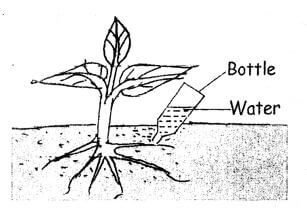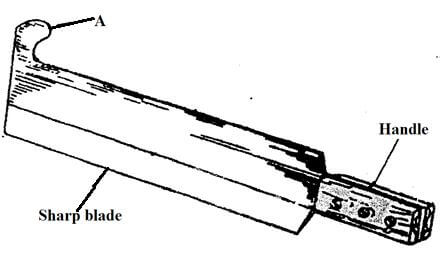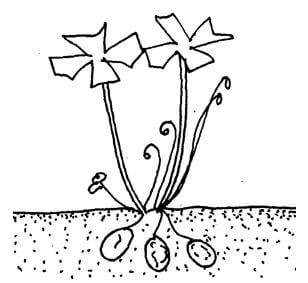INSTRUCTIONS TO THE CANDIDATES
- Write your name and index number in the spaces provided above.
- This paper consists of three sections;-A, B and C.
- Answer all questions in section A and B and any two questions in section C
- All answer must be written in the spaces provided.
- This paper consist of 13 printed pages.
- Candidates should check the question papers to ascertain that all the pages are printed as indicated and that no questions are missing.
- Candidates should answer the question in English.
For Examiners Use Only
|
Section |
Question |
Maximum Score |
Candidates Score |
|
SEC -A |
1-15 |
30 |
|
|
SEC -B |
16-19 |
20 |
|
|
SEC- C |
20 |
20 |
|
|
21 |
20 |
||
|
22 |
20 |
||
|
TOTAL SCORE |
90 |

QUESTIONS
SECTION A (30 marks)
ANSWER ALL QUESTIONS IN THIS SECTION
- State four reasons for practicing grafting in citrus production (2mks)
- Mention four types of soil erosion by water (2mks)
- Differentiate between coppicing and pinching out (2mks)
- Give four benefits of possessing certificate of land ownership (2mks)
- Give one reason why each of the following nursery management practices are carried out. (2mks)
- Hardening off
- Watering before transporting seedlings from the nursery bed
- Name four effects of excessive nitrogenous fertilizer application on tomatoes (2mks)
- State four early maturing varieties of cabbages (2mks)
- State four ways by which Agriculture contributes to national development (2mks)
- List four methods of land acquisition (2mks)
- State four roles of trees in soil and water conservation (2mks)
- State any four types of livestock farming (2mks)
-
- State two ways by which a soil of pH 3 can be raised to pH 5 (1 mk)
- Name any two types of soil structures (1mk)
- State four factors that determine the number of secondary cultivation to be done on a seedbed (2mks)
- Mention any four factors that should be considered when selecting site for making compost manure (2mks)
-
- Define the following terms:
- Opportunity cost (1/2 mk)
- Agricultural economics (1/2mk)
- Give two types of farm records that a large scale farmer should keep (1mk)
- Define the following terms:
SECTION B (20 marks)
ANSWER ALL QUESTIONS IN THIS SECTION
- The diagram below shows a method of irrigation

- Identify the method (1 mark)
- State two advantages of the irrigation system named in (a) above. (2mks)
- State any two factors to be considered when choosing the method of irrigation to use in an area (2mks)
- The diagram below is a tool used to harvest crops in the farm. Use it to answer the questions that follow

- Identify the tool represented above (1 mark)
- Name the crop harvested by use of the tool above. (1 mark)
- Name the part labeled A on the tool (1 mark)
- Give one reason why the crop named in (b) above should be cut at ground level (1 mark)
- Give a reason why the leaves of the crop should be removed after cutting (1 mark)
- An agronomist recommends application of 130kg N, 55kg P2O5 and 65kg K2O after testing a soil sample. Calculate the amount of urea (46%N), Single super phosphate (20% P2O5) and Potassium chloride (50% K2O) that should be applied on the land. (5mks)
- The diagram below illustrates a weed

- Identify the weed (1 mark)
- State one competitive ability of the weed illustrated above. (1 mark)
- State two mechanical control measures for the weed above (2mks)
- Classify the weed above according to plant morphology (1 mark)
SECTION C (40 MARKS)
ATTEMPT ANY TWO QUESTIONS IN THE SPACE PROVIDED
-
- Describe five qualities of mother plant that should be considered when selecting vegetative materials for planting (5 marks)
- List seven benefits of using organic matter for mulching (7 marks)
- Describe the field production of nappier grass under the following sub-headings
- Planting (3 marks)
- Fertilizer and manure application (3 marks)
- Utilization (2marks)
-
- Describe the procedure of silage making (8 marks)
- State and explain four factors that determine the depth of planting (8 marks)
- Outline four roles of Agriculture in Kenya’s economy (4 marks)
-
- Outline seven effects of land fragmentation and subdivision (7 marks)
- State and explain three methods of pruning (6 marks)
- Describe the establishment of vegetative propagation nurseries (7 marks)

MARKING SCHEME
- State four reasons for practicing grafting in citrus production (2mks)
- Plants with desirable root characteristics but with undesirable fruits can be used to produce desirable fruits.
- Facilitates changing the top of the tree from being undesirable to desirable.
- Makes it possible to grow more than one type of fruit on the same plant.
- Repair of damaged trees.
- Shorten maturity age.
- Less thorny.
(4 x ½ mks)=2mks
- Mention four types of soil erosion by water (2mks)
- Splash/Raindrop erosion
- Sheet erosion
- Rill erosion
- Gully erosion
(4 x ½ mks) =2mks
- Differentiate between coppicing and pinching out (2mks)
- Coppicing is a method of harvesting trees by cutting the stem to leave about 15cm above the ground, while pinching out is a method of pruning where the terminal bud is removed to encourage lateral growth.
(Mark as a whole)
- Coppicing is a method of harvesting trees by cutting the stem to leave about 15cm above the ground, while pinching out is a method of pruning where the terminal bud is removed to encourage lateral growth.
- Give four benefits of possessing certificate of land ownership (2mks) - Can be used to secure credit facilities
- Confer security of tenure
- Encourages the farmers to invest on long term projects
- Enable the land owner to lease part of whole of the land
(4 x ½ mks)
- Give one reason why each of the following nursery management practices are carried out. (2mks)
- Hardening off
- Prepares the seedlings to adapt to the ecological conditions of the seedbed
- Watering before transporting seedlings from the nursery bed
- Enable lifting seedlings with a lump of soil
(2 x 1 = 2mks)
- Enable lifting seedlings with a lump of soil
- Hardening off
- Name four effects of excessive nitrogenous fertilizer application on tomatoes (2mks)
- Blossom end rot
- Too much vegetative growth
- Cracking of fruits before maturity
- Prolonged maturity
(4 x ½ mks) =2mks
- State four early maturing varieties of cabbages (2mks)
- Sugar loaf
- Mukuki
- Golden acre
- Gloria hybrid
- Copenhagen market
(4 x ½ mks) =2mks
- State four ways by which Agriculture contributes to national development (2mks)
- Food supply
- Market for industrial goods
- Foreign exchange
- Source of raw materials
- Tax to government
(4 x ½ mks) =2mks
- List four methods of land acquisition (2mks)
- Inheritance
- Buying
- Settlement and resettlement by government
- Compensation
(4 x ½ mks) =2mks
- State four roles of trees in soil and water conservation (2mks)
- Protects soil against strong rain drops
- Act as windbreakers
- Roots bind soil particles together preventing soil erosion
- Reduce speed of surface run-off
- Leaves decay to supply humus
(4 x ½ mks) =2mks
- State any four types of livestock farming (2mks)
- Pastoralism
- Fish farming
- Bee keeping
- Poultry keeping
(4 x ½ mks) =2mks
-
- State two ways by which a soil of pH 3 can be raised to pH 5 (1 mk)
- Application of lime
- Application of basic fertilizer
- Name any two types of soil structures (2mks)
- Single-grained
- Crumby
- Granular
- Prismatic/columnar
- Platy
- Blocky
(2x ½=1mk)
- State two ways by which a soil of pH 3 can be raised to pH 5 (1 mk)
- State four factors that determine the number of secondary cultivation to be done on a seedbed (2mks)
- Size of planting materials
- Slope of land
- Moisture content of soil
- Condition of land after primary cultivation
(4 x ½ mks) =2mks
- Mention any four factors that should be considered when selecting site for making compost manure (2mks)
- Well drained place
- An accessible area
- Located at the centre of the farm
- Away from the direction of prevailing wind
-
- Define the following terms:
- Opportunity cost (1/2 mk)
- Is the value of the foregone alternative
- Agricultural economics (1/2mk)
- A branch of Agriculture that deals with utilization of scarce resources
- Opportunity cost (1/2 mk)
- Give two types of farm records that a large scale farmer should keep (1mk)
- Health records
- Breeding record
- Inventory record
- Production record
(2 x ½ = 1mk)
- Define the following terms:
- The diagram below shows a method of irrigation
- Identify the method (1 mark)
- Drip/Trickle irrigation
- State two advantages of the irrigation system named in (a) above. (2mks)
- Minimizes labour requirement
- No need to construct dykes
- Practised on both sloppy and flat lands
- Water does not cause erosion
- Reduce incidences of fungal diseases
- Economises on use of water
- Minimizes possible theft of pipes
(2 x 1 = 2mks)
- State any two factors to be considered when choosing the method of irrigation to use in an area (2mks)
- Capital availability
- Topography of land
- Water availability
- Type of soil
- Type of crops to be irrigated
(2 x 1 = 2mks)
- Identify the method (1 mark)
- The diagram below is a tool used to harvest crops in the farm. Use it to answer the questions that follow
- Identify the tool represented above (1 mark)
- Cane harvesting matchet
- Name the crop harvested by use of the tool above. (1 mark)
- Sugarcane
- Name the part labeled A on the tool (1 mark)
- Cane felling hook
- Give one reason why the crop named in (b) above should be cut at ground
- level (1 mark)
- To avoid loss of yield
- To ensure proper establishment of ratoon crop
(1 x 1mk)
- Give a reason why the leaves of the crop should be removed after cutting (1 mark)
- To avoid some growth substances from flowing back
- To avoid lowering the quality of sugar
- Identify the tool represented above (1 mark)
- An agronomist recommends application of 130kg N, 55kg P2O5 and 65kg K2O after testing a soil sample. Calculate the amount of urea (46%N), Single super phosphate (20% P2O5) and Potassium chloride (50% K2O) that should be applied on the land. (5mks)
- Urea (46% N)
- 100kg Urea → 46kg N
? ← 130kg N
130 x 100 = 282.6 = 283kg Urea
46
- 100kg Urea → 46kg N
- SSP (20% P2O5)
100kg SSP → 20kg P2O5
? ← 55kg P2O5
100 x 55 = 275kg SSP
20 - KCL (50% K2O)
100kg KCL → 50kg K2O
? ← 65kg K2O
100 x 65 = 130kg KCL
50
- Urea (46% N)
- The diagram below illustrates a weed
- Identify the weed (1 mark)
- Oxalis/Oxalis latifolia/Oxalis spp
- State one competitive ability of the weed illustrated above. (1 mark)
- Underground structures (bulbs) that regenerate
- State two mechanical control measures for the weed above (2mks)
- Digging out/ tillage
- Slashing
- Uprooting
(2 x 1= 2mks)
- Classify the weed above according to plant morphology (1 mark)
- Broad-leafed
- Identify the weed (1 mark)
-
- Describe five qualities of mother plant that should be considered when selecting vegetative materials for planting (5 marks)
- High yielding
- Resistant to pests and diseases
- High quality produce
- High rooting ability
- Early maturing
- List seven benefits of using organic matter for mulching (7 marks)
- Improves soil aeration upon decomposition
- Reduced toxicity of plant poisons upon decomposition
- Reduces soil erosion
- Improves soil structure on decomposition
- Modifies the soil temperature
- Adds nutrients on decomposition
- Improves water infiltration
- Increases microbial activity
- Controls weeds
- Reduces evaporation of water
- Buffers soil pH upon decomposition
(7 x 1-7mks)
- Describe the field production of nappier grass under the following sub-headings
- Planting (3 marks)
- Plant at the onset of the rains/early planting
- Select desirable nappier grass variety for the ecological area
- Use healthy planting materials
- Use cuttings/canes or splits for planting
- Cuttings/canes should have 3-5 nodes
- Select cutting from mature canes/stems
- Place planting materials in furrows/holes
- Cover the planting materials with soil to appropriate depth
- Fertilizer and manure application (3 marks)
- Apply phosphatic fertilizer during planting
- Apply farmyard/compost manure for planting
- Rate of organic manure should be 7-10 tons/ha
- Apply organic manure after harvest and incorporate into the soil
- Top-dress with nitrogenous fertilizer (CAN) 6-8 weeks after planting
- Utilization (2marks)
- Cut and feed to the ruminants
- Defoliate/cut at the right stage of growth 3-5 months old whne stems are 1-1.5high
- Cut the stems at 2.5-5cm above the ground surface
- Use a sharp panga for cutting
- Conserve excess as silage
- Chop napier grass into small pieces
- It can be dried and used as mulch
- Planting (3 marks)
- Describe five qualities of mother plant that should be considered when selecting vegetative materials for planting (5 marks)
-
- Describe the procedure of silage making (8 marks)
- Prepare the silo before harvesting the crop
- Cut the crop at the appropriate stage
- Chop up the crop and put into a silo compacting it every 10-12cm layer
- Fill the silo rapidly (preferably 2 days)
- Check the temperature regularly and maintain it at appropriate range
- Cover with polythene to protect it from water and air
- Cover the silo with a thick layer of soil to maintain the ridge appearance
- Dig a trench around the silo to drain off rain water
(8 x 1=8mks)
- State and explain four factors that determine the depth of planting (8 marks)
- Soil type – plant deeper in light soils such as sands and shallower in heavy soils e.g. clay
- Soil moisture content – plant deep in dry soils to place the seeds in a moist zone
- Size of the seed – larger seeds are planted deeper in soils than the smaller ones
- Type of germination – seeds with epigeal type of germination should be planted shallower than those with hypogeal type
- Outline four roles of Agriculture in Kenya’s economy (4 marks)
- Food supply
- Source of employment
- Provision of foreign exchange
- Source of raw materials for industries
- Provision of market for industrial goods
- Source of money or capital
- Describe the procedure of silage making (8 marks)
-
- Outline seven effects of land fragmentation and subdivision (7 marks)
- Time is wasted while travelling from one holding to another
- Difficult to control weeds and pests
- Difficult to follow a sound farm plan
- Difficult to supervise the scattered plots
- Difficult to control parasites and diseases
- Difficult to carry out soil conservation measures
- Impossible to control grazing
(7x1=7mks)
- State and explain three methods of pruning (6 marks)
- Annual pruning
- Involves the removal of branches that have borne two crops and have undesirable characteristics
- Pinching out
- Involves the removal of terminal buds
- Coppicing or pollarding
- Carried out in tree crops where branches are cut at specified points in order to achieve a desired shape
Stating – 1mk explaining – 1mk = 6mks
- Carried out in tree crops where branches are cut at specified points in order to achieve a desired shape
- Annual pruning
- Describe the establishment of vegetative propagation nurseries (7 marks)
- Select the suitable site
- Clear and level the site
- Establish vegetative propagation unit measuring 3.66m by 1.22m
- Fill polythene sleeves measuring 7-10cm in diameter and 20-30cm long with a rooting mixture
- Water the sleeves
- Insert the cuttings seedlings at the centre of each sleeve
- Arrange the sleeves in the propagation unit
- Erect wooden loops over the sleeved cuttings
- Place polythene sheet on the loops
- Burry the polythene sheet into the ground at the edges
(7x1=7mks)
- Outline seven effects of land fragmentation and subdivision (7 marks)
Download Agriculture Paper 1 Questions and Answers - Cekenas Pre Mocks 2022.
Tap Here to Download for 50/-
Get on WhatsApp for 50/-
Why download?
- ✔ To read offline at any time.
- ✔ To Print at your convenience
- ✔ Share Easily with Friends / Students

